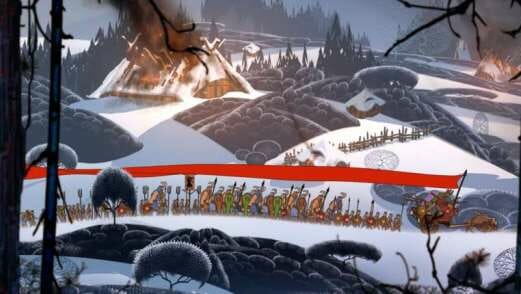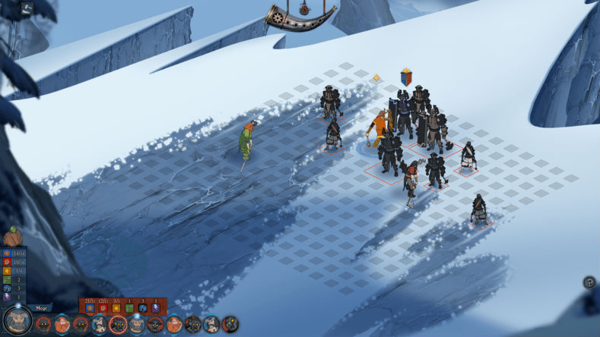
Something about the Vikings appeals to our most primal aspirations. Frigid oceans and snowcapped mountains, bloodthirsty gods and ancient steel—maybe it resonates because once upon a time, this brutal world might’ve actually existed. If you read Njal’s Saga, an ancient Icelandic epic that is undeniably one of the primary inspirations for The Banner Saga, you’ll dive into a tradition of blood feuds, vengeance and a whole lot of jilted masculinity. It’s grisly stuff, equipped with enough sadism to fuel a modern obsession. But outside of antiquity, it’s hard to point to the defining work of our romanticized, Americanized version of Norse mythology—until now. Stoic’s debut strategy game is very proud of its brand new universe, and despite a vicious grasp The Banner Saga is rendered and drawn so impeccably that you’ll barely notice its shortcomings.
There are three primary races in The Banner Saga: the humans, who are allied with horned giants known as the Varl, who are both locked in war with a nation of obsidian, vaguely Iron Giant-looking creatures called the Dredge. You control a rotating cast of characters, who are mostly trying to outpace the recently returned Dredge into some kind of sanctuary. Rumors of a world-ending event persist—the gods are dead, the sun refuses to set and there’s a giant serpent sinking mountains into the ground. The fiction of The Banner Saga is incredibly dense. At any moment you can open up a world map and find a practical encyclopedia, some of which don’t even make a physical appearance. (Are “horse-born” born on a horse or of a horse?) It’s clear that this is a universe built with a long, generational arc in mind.
The Banner Saga divides itself up into two primary phases. For much of the game you’ll be staring at your caravan scrolling through a parallax world headed towards your latest destination, days ticking by overhead. It’s a basic resource-management sim, with rations, morale and manpower under your watch. This is also where the game’s art direction shines the most. The quality of the animations and vistas are almost Disney like, and the way the landscape shifts in layers behind you as your caravan rumbles through the tundra is utterly spellbinding. You’re made to look so small in this ancient, unforgiving world that it’s hard to not read the implied sense of history etched on the landscapes. You can’t play The Banner Saga without getting curious about the places you’re inhabiting. So many fantasy worlds fall by the wayside, but the transformative power of an iconic art style can never be underrated.
You’ll occasionally encounter random events on the road, most of which are solved through a few textbox decisions. They’re essentially just more elaborate takes on the usual Oregon Trail tragedies. But most of the major plot points come attached with a combat scenario. The Banner Saga works like a traditional grid-based strategy game. Think Fire Emblem, Final Fantasy: Tactics or a slower XCOM: Enemy Unknown. You have a handful of heroes facing any number of enemies (usually Dredge), all with their own unique abilities and roles. The combat usually takes place in tight spaces, and mobility and positioning become vital to your success. As such, The Banner Saga can get a little punishing if you’re not careful. An efficient battle takes a lot of patience.
Despite its depth, The Banner Saga sadly limits itself with its monotonous enemy design. You’ll spend almost the entirety of the campaign fighting the Dredge, and while they’re certainly menacing, it does begin to drag. I found myself trying to avoid battle, simply because I didn’t want to get locked in another stifling stalemate with another collection of charcoal warlords. For a universe that’s been given such obvious care, the lack of enemy diversity is a little bit surprising. Strategy games are predicated on progressively updated strategies as the situations mutate, but combat in The Banner Saga falls into routine too easily.
The Banner Saga’s story helps set up a longer, grander journey that will undoubtedly continue in the future, but almost all of the narrative is told through text boxes. That’s not necessarily a bad thing—there are limits to an indie developer’s capabilities—but for a game that requires so much exposition to give its universe meaning, it’s a shame Stoic couldn’t invest a little bit more in voice work. It’s hard to simply read dialogue and look at character portraits to understand context, and because of that The Banner Saga’s character hooks can feel a tad dry. That being said, there is a lot of good character moments and soul-twisting moral choices, and that’s certainly something to build on. The Banner Saga is essentially our introduction—it’s a bunch of fantasy role-playing geeks getting together to sell us on their brand new setting in their brand new universe. It’s a promise to tell larger stories with bigger budgets in the future. As far as that goes, they’ve totally nailed it. You’ll scarcely find a more convincing sales pitch.
The Banner Saga was designed by Stoic. It is available for the PC and Mac.
Luke Winkie is a writer and former pizza maker from San Diego, currently residing in Austin. He writes about music, sports and videogames for The Austin Chronicle, Red Bull Music, Myspace, The Village Voice and Salon.
